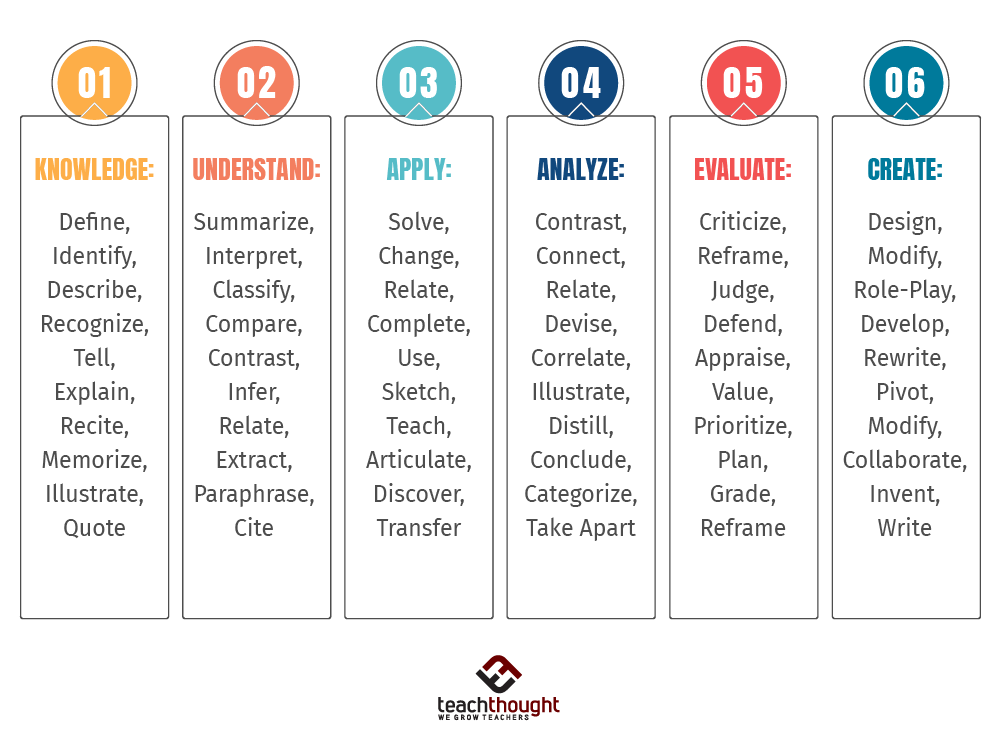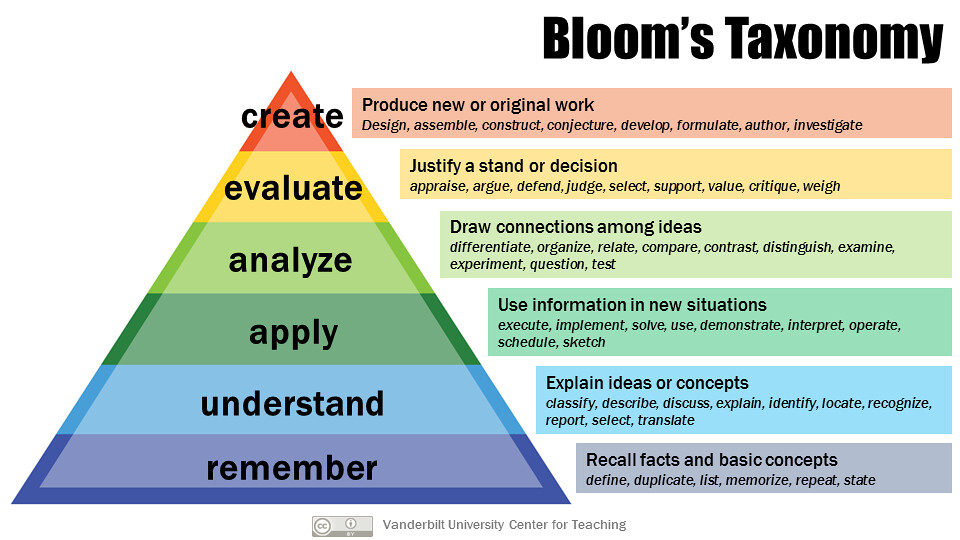Over my 40-year career in education, I have come to recognize that what I was taught back in college about being an effective teacher is not necessarily true today. It’s not just because times have changed (they have), students have changed (they have), or the world has changed (it has). It’s because, over the past 30 years, more research has been done on what works best in teaching and learning than in all the years before that. And the results of all of that research are startling, to say the least. One of the most astonishing findings has to do with the value of following Bloom’s Taxonomy.
The History of Bloom’s
The taxonomy was created in 1956 by Benjamin Bloom and some of his colleagues as a way to leave behind behaviorist theories of learning that were being used at the time (memorization, rote learning) and embrace higher-order thinking skills. They incorporated aspects of cognitive, affective, and psycho-motor domains into the taxonomy to make it more all-encompassing. It was a radical change in how educators were taught to teach. Then, in 2001, Anderson and Krathwohl offered a revision to Bloom’s, indicating that “in the cognitive domain, creation appears as a higher-order process as compared to evaluation.”
Bloom’s Taxonomy is easy to implement. We are all familiar with the “verb chart” that lets us select the level of thinking we want our students to work at. We pick a content standard, decide what level it is best learned at, find a verb at that level in the chart, create the learning activity, and we’re done. But is this approach still valid today?

Why Bloom’s May Not Be the Best Approach
The first reason to reconsider using Bloom’s Taxonomy in the classroom has to do with how the brain works. Thinking does not operate within hierarchies (as outlined in the taxonomy). All of these “levels” happen simultaneously in a variety of places in the brain.
The second reason to stop relying on Bloom’s is that it was created before rigorous research into its effectiveness was put in place. At more than 60 years old, the taxonomy is simply not supported by any empirical research on learning. The only piece of this hierarchical approach that is validated today is the existence of factual-conceptual knowledge, often called prior knowledge. But there is no clear research on its basic assumption that there are lower- and higher-order thinking skills. The brain doesn’t look at a problem to be solved and decide that it only needs a lower-order process.
The third reason Bloom’s may not be the approach you want to follow in your classroom has to do with new research on the social relation of persons in the creation of knowledge. The taxonomy does not consider the learner and the differences that each learner brings to the table. Motivation, their intellectual values, their past experiences with the content, their differences in cognitive processing: none of these are considered. The approach is based on the belief that all learners are at the same place in their learning, which is inherently false. In short, Bloom’s Taxonomy focuses on abstract cognitive domains and not on the individual learner. It is teacher-centered and not student-centered.
Conclusions to Take Away and Next Steps
I realize that this blog may shock some educators. And for that, I’m sorry. But we want to put our time, effort, and focus into instructional strategies and approaches that we know will work best for our students. And I believe that we must stay current with what the latest (and verified!) research says in order to do so.
So what might your next steps be? Make time to examine what the latest and best research says about effective teaching and learning. TCEA has a series of blogs on instructional strategies that have been proven to work, as well as several online, self-paced courses that will help you dive into how to apply the best approaches in your classroom. Be open to new ideas and new ways to help your students master the content. Question the strategies that are your “favorites” and ensure that they are based on valid, current research. And talk with your colleagues and administrators about getting more professional learning on the most effective teaching methods.
Research and Supporting Articles
- Anderson, L. W., & Krathwohl, D. R. (2001). A taxonomy for learning, teaching, and assessing: A revision of Bloom’s taxonomy of educational objectives. New York: Longman.
- Bandura, A. (2001). Social Cognitive Theory: An Agentic Perspective. Annual Review Of Psychology, 52(1), 1
- Bandura, A. (2006). Toward a Psychology of Human Agency. Perspectives on Psychological Science, (2). 164.
- Barney, Jason (2021). Breaking Down the Bad of Bloom’s: The False Objectivity of Education as a Modern Social Science.
- Berger, Ron (2018). Here’s What’s Wrong with Bloom’s Taxonomy: A Deeper Learning Perspective.
- Bloom, B. S.; Engelhart, M. D.; Furst, E. J.; Hill, W. H.; Krathwohl, D. R. (1956). Taxonomy of educational objectives: The classification of educational goals. Handbook I: Cognitive domain. New York: David McKay Company.
- Briñol, P., & DeMarree, K. G. (2012). Social metacognition. New York, NY: Psychology Press.
- Case, Roland (2013). The Unfortunate Consequences of Bloom’s Taxonomy.
- Deci, E. L., & Ryan, R. M. (2012). Motivation, personality, and development within embedded social contexts: An overview of self-determination theory. In R. M. Ryan (Ed.), Oxford handbook of human motivation (pp. 85-107). Oxford, UK: Oxford University Press.
- Efklides, A. (2006). Metacognition and affect: What can metacognitive experiences tell us about the learning process? Educational Research Review, 13-14.
- Kim, Y. R., Park, M. S., Moore, T. J., & Varma, S. (2013). Multiple levels of metacognition and their elicitation through complex problem-solving tasks. The Journal Of Mathematical Behavior, 32(3), 377-396.
- Schraw, G., & Moshman, D. (1995). Metacognitive Theories. Educational Psychology Review, (4). 351.
- Schraw, G., Crippen, K. J., & Hartley, K. (2006). Promoting Self-Regulation in Science Education: Metacognition as Part of a Broader Perspective on Learning. Research In Science Education, 36(1-2), 111-139.


